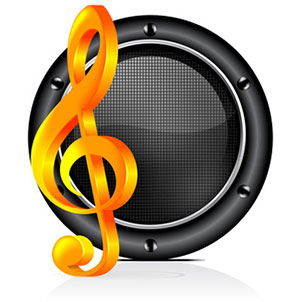 Your monitoring setup is super important if you are recording music. I would say that it is much less important for voice-over or video narration for a number of reasons, but primarily due to the fact that only your voice is being recorded, which is a pretty simple sound source at a predictable frequency that it doesn’t have to share.
Your monitoring setup is super important if you are recording music. I would say that it is much less important for voice-over or video narration for a number of reasons, but primarily due to the fact that only your voice is being recorded, which is a pretty simple sound source at a predictable frequency that it doesn’t have to share.
With music though, you have multiple sound sources with energy at multiple frequencies, many of which overlap. That means you have instruments (including vocals) often competing for the same frequency real estate. That can cause some sounds to be hidden or masked in a mix. But on top of all of that is the enormous problem of monitoring in a less-than-acoustically-ideal room. Hint: for those of use monitoring music in rectangular rooms, like bedrooms, our monitoring spaces are less-than-ideal by definition. Sound waves coming out of the speakers bounce off the walls and ceilings and collide with other waves. The parallel boundaries (walls, celings, floors) create areas where certain frequencies combine to sound much louder than they really are (yes, the room lies to you!), or do the opposite – make certain frequencies sound much softer than they really are. Sometimes in the latter situation, frequencies disappear altogether!
So imagine mixing in such a room. If bass frequencies are being hyped by the room, and certain middle frequencies are disappearing, you will turn the bass down and the middle frequencies up until they sound “right.” But then in a different space, or on an iPod, etc. suddenly the song has no bass at all, and the mids are ripping your sinuses out!
The solution to controlling a monitoring setup is a combination of knowing your mixing room and its tendencies, and doing as much acoustic treatment as you can do reduce the distorting effects of the room. You can also make sure you listen in different spaces to help you get to the “truth” of the mix and then compensate accordingly.
So let’s say you have gotten used to your room and maybe treated it as well. You know how to create a good, portable (meaning it will sound good anywhere it’s played). But suddenly you either have to move, or mix in an unfamiliar room or studio. That new room will sound strange to your ears. You need to be able to calibrate your ears to that new space.
Here is a great article telling you how to do that quickly by creating your own playlist of songs that you can use to test the acoustic aspects of the new room. They recommend 6-10 songs, each designed to test a different parameter like stereo imaging, dynamic range, 3D imaging, low frequency response, high frequency response, etc.
Read the full article here:
http://en.audiofanzine.com/getting-started/editorial/articles/how-to-control-a-monitoring-system.html
frequency
What Is A Decibel In Audio Recording?
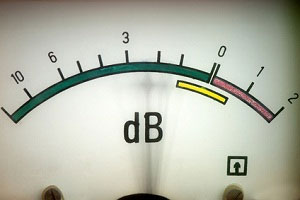 The term “decibel” is used a LOT in audio recording and live sound. You usually see it written as “dB,” and talked about primarily when discussing frequency stuff, especially in the topics of EQ and compression. Besides sounding vaguely like something to do with the decimal system, what does it mean?
The term “decibel” is used a LOT in audio recording and live sound. You usually see it written as “dB,” and talked about primarily when discussing frequency stuff, especially in the topics of EQ and compression. Besides sounding vaguely like something to do with the decimal system, what does it mean?
Well, the short answer – and the one that will be most useful to you without having to know the gory technical details – is that it is a unit of measure for how loud audio is. For example, when you want to know how long something is, you measure in units of inches, feet, yards, etc. Or if you use the decimal system, centimeters, meters, etc. The decibel is something like that, only for loudness of audio, and it uses the decimal system like a lot of things in audio.
But there are some funky things about the decibel. For one thing, it is almost always referred to as a negative number in digital audio, where zero is the top of the scale. What? Yup. It’s like going through the looking glass and doing everything backwards. If you want to make -20 dB audio louder, you turn it up until it gets to -15 dB, or more. See? Funky!
In fact it’s so funky that there is a move afoot (or should that be “adecimeter”? – ha! Sorry:)) to do away with it altogether in the audio recording world! And in a world where obtuse and often needlessly complicated terms are commonplace, that is saying something.
Here is a terrific article from Recording Magazine by Alex Case about the decibel, which is written in a pretty easy-to-understand way. Still, the term “logarithm” does appear. So be prepared to put on your math trousers.
The article is here: http://www.recordingmag.com/resources/resourceDetail/265.html
What Is Multiband Compression?
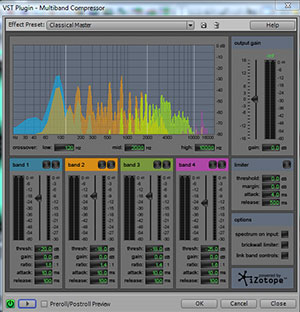 Multiband compression is an incredible audio tool if you can get past the fact that it, like many other terms in audio, is a bit scary and technical sounding. It’s mainly used when mastering a song (see our article Mastering a Song – What Does It Mean? for a review of what mastering means), when everything is all mixed together and you only have one audio file. To understand what multiband compression is, you should first have a good idea what regular old compression is.
Multiband compression is an incredible audio tool if you can get past the fact that it, like many other terms in audio, is a bit scary and technical sounding. It’s mainly used when mastering a song (see our article Mastering a Song – What Does It Mean? for a review of what mastering means), when everything is all mixed together and you only have one audio file. To understand what multiband compression is, you should first have a good idea what regular old compression is.
In two previous articles, I wrote about compression basics – Improve Or Ruin Your Audio With an Effect Called Compression and Should You Use Compression In Audio Recording? So if you’re feeling a little rusty on your understanding, give those a quick read.
So back to our question – what is multiband compression? Assuming we know that compression means “turning down” audio loudness ONLY when it gets louder than a certain volume (i.e. the singer’s voice goes happily along with no volume reduction; but during that part in the chorus where he screams, it gets louder than the “threshold” you set on the compressor. So just during the screaming parts, the compressor turns the volume down), multiband compression does the same thing, but we get more control over which frequencies get compressed. Simple right?
Multiband Compression Versus EQ
OK, how about an example? If we have already mixed a song down (so it’s just one file now with all the instruments blended together), and it sounds fabulous except the bass sounds too loud for the song, we have two choices. We can try to use an equalizer effect to lower only certain frequencies (see our post What is Equalization, Usually Called EQ? for more on that). But equalizers turn down (or up) the volume at a targeted frequency or set of frequencies (or “band” or frequencies) regardless of how loud they are. Remember that a compressor won’t turn something down until it gets to a certain volume that you deem to be the place it should be turned down (called a “threshold”). So maybe the EQ isn’t controlling the bass, the low frequency parts of the song as much as you want. So now what?
Well, if you have a multiband compressor (like the one pictured above, which is the iZotope multiband compression plugin that came with Adobe Audition 3), you can apply compression to JUST the low frequency, bass-y frequencies (most compressors operate across the entire frequency spectrum). Unlike an EQ, a compressor will allow everything to play with no volume reduction until it goes past the threshold volume level. So maybe your bass is all good except for one note that keeps popping out of the mix. Or maybe 80 percent of the song has a good bass mix, but during the pre-choruses, things start swimming in bass. A multiband compressor that is ONLY targeting bass frequencies will not do anything until those pre-choruses, which trigger the compression to start reducing bass. Then when the pre-chorus is over, and the bass drops back below the threshold, the compressor stops compressing; that is until the next time some bass notes get too loud, and then it kicks in again, etc. So in a way, a multiband compressor is sort of like EQ in that you can target certain frequency bands (more like a graphic EQ than a parametric EQ in that way). But since compression is different in that it only affects the audio above a specified loudness threshold, it may well be able to solve a problem that EQ cannot.
The multiband compressor plugin shown in the picture above allows you to set 4 different bands. You can just drag the lines on the graph that determine the border between two bands to select how you want to divide things up. Once you do that, you have all the normal compressor controls (threshold, ratio, etc.) available for each band, which you can now set individually and independently of the others. So you could apply a lot of compression in the bass range, say everything from 150 Hz down, while applying no compression at all to a mid-range band of 150 to 800 Hz, mildly compressing high mids of 800Hz to 2KHz, and not compressing anything above 2KHz – all simultaneously with one effect.
Mainly Used While Mastering
When a song is in the mixing stage, each instrument has its own track. So if the bass is too uneven, you can simply stick a compressor on the bass guitar track to even it out. And if the kick drum is interfering with the bass guitar, you can compress and/or EQ just the kick drum track. The same is true for every other frequency range. Maybe there is excess sibilance on the lead vocal. OK, just put an EQ on the lead vocal track and subtract loudness in the sibilance range, typically 4-8 KHz (for a review on sibilance and how to treat it, see our post How to Fix SSS-Sibilance in Your Audio With Sound Editing Software). If a guitar (or any instrument) is harsh and grating on your ears, you can put an EQ or compressor on the guitar track and treat that problem on that track. The point is that you can isolate the problem audio sources and treat them surgically on their own tracks.
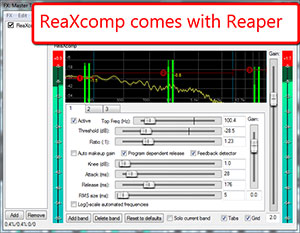 However, a mastering engineer receives “mixed down” audio (see our post What Does It Mean to Mix Down Audio?), all the instruments are already blended together into one file, so you cannot treat JUST the bass guitar, or JUST the lead vocal anymore. It’s like making a cake. Once everything is done and frosted, if you notice there was too much almond extract used in the recipe, well it’s too late to do anything about that. But a mastering engineer can come close to isolating elements of a mixed-down song (cake) using EQ and multiband compression, and may actually be able to reduce the almond extract flavor even after the cake is baked – to stretch that metaphor a little:).
However, a mastering engineer receives “mixed down” audio (see our post What Does It Mean to Mix Down Audio?), all the instruments are already blended together into one file, so you cannot treat JUST the bass guitar, or JUST the lead vocal anymore. It’s like making a cake. Once everything is done and frosted, if you notice there was too much almond extract used in the recipe, well it’s too late to do anything about that. But a mastering engineer can come close to isolating elements of a mixed-down song (cake) using EQ and multiband compression, and may actually be able to reduce the almond extract flavor even after the cake is baked – to stretch that metaphor a little:).
If you would like to try a multiband compressor, and you already have Reaper recording software, you’re in luck! One of the many effects plug-ins that come with Reaper is ReaXcomp, a multiband compressor. Most 3rd party MBC plug-ins cost at least $200 and go up from there. So the fact that you get one free with Reaper is pretty amazing. If you don’t already have Reaper, go download it now for free (http://www.cockos.com/reaper/download.php). They have a 60-day trial that is fully functional. And when the trial is done, you only pay $60 for the license. Then if you make $20,000 per year using their software, you pay for the commercial license for $250. And it’s all on the honor system! All versions of the software – trial, personal license, and commercial license – are identical and fully functional.
So now you know. Multiband compression is just a compressor that lets you apply different settings to different frequencies all at the same time. Go forth and create better music.
Cheers!
Ken
Equalization On Kick and Snare Drums
Equalization – or EQ for short – on drums is pretty important. Arguably the two most important drums to focus on in a standard drum kit are the kick and the snare. In the video below, you’ll see some excellent tips on EQ settings for both of those drums.
Basically, you want to add some energy at 70 and 100 Hz for the kick, for that boomy bassy sound. This also leaves you room to boost your bass guitar at around 80 hz to help it not conflict with the kick. There are a few other settings he shows you as well.
For the snare, it starts out with boosting the highs from 5 KHz and up using a shelving EQ (lifts all the frequencies at the target frequency and above (or below for a low-end shelf) for added sizzle, crack and air. Then for some punch and presence, there is a boost at about 250 Hz.
They use Apple’s Logic Express (the baby brother of Logic Pro) for their demo, but the same tips are true for any mixing session or software you use, including Reaper.
Check out the video below:
Reasons To Use EQ On Your Recorded Audio
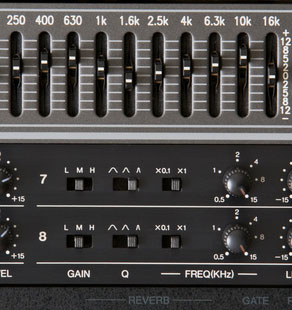 I’ve been writing a lot about EQ this past week – starting with a basic explanation of frequencies and equalization in Some Good Equalization and Frequency Basics. I’ve talked a little about how to use an equalizer effect (EQ for short) to improve your recordings by either removing or turning down unwanted frequencies, or boosting certain frequencies. Now we should pull back a bit and talk about the bigger picture. Why should you use EQ? Like a lot of tools in audio recording, once you learn about how cool an effect is, you start to feel like you have to use it all the time. But that is the road to audio hell. Before you use any tool, ask yourself why you’re doing it. Does your audio really need the effect? If not, it is better to not apply any treatment. It’s kind of like medication. Often we find ourselves just taking it out of habit even if we don’t need it anymore. But all things being equal, our bodies, like our audio, are probably better off clean and sober. Don’t get me wrong. I’m a big believer in better living through chemistry, and I love me some EQ and compression and reverb on my tracks too. Just make sure you’re doing it for the right reasons.
I’ve been writing a lot about EQ this past week – starting with a basic explanation of frequencies and equalization in Some Good Equalization and Frequency Basics. I’ve talked a little about how to use an equalizer effect (EQ for short) to improve your recordings by either removing or turning down unwanted frequencies, or boosting certain frequencies. Now we should pull back a bit and talk about the bigger picture. Why should you use EQ? Like a lot of tools in audio recording, once you learn about how cool an effect is, you start to feel like you have to use it all the time. But that is the road to audio hell. Before you use any tool, ask yourself why you’re doing it. Does your audio really need the effect? If not, it is better to not apply any treatment. It’s kind of like medication. Often we find ourselves just taking it out of habit even if we don’t need it anymore. But all things being equal, our bodies, like our audio, are probably better off clean and sober. Don’t get me wrong. I’m a big believer in better living through chemistry, and I love me some EQ and compression and reverb on my tracks too. Just make sure you’re doing it for the right reasons.
So that being said – what are the reasons for using EQ? Let’s review what an EQ is. It is basically a bunch of volume knobs, each targeting a small band of frequencies (this describes a graphic EQ type, as opposed to a parametric EQ where you “dial-in” the frequency and the bandwidth you want to turn up or down), whereas a master volume knob turns up or down ALL frequencies equally. This allows us to JUST boost or cut, say the frequencies around 6Khz. That’s usually where sibilance is located, so a reduction in that area can help reduce overly hot “SSS” sounds, for example. So you really should always ask yourself some questions before applying EQ. Graham Cochrane just wrote an article about this called “3 Questions I Always Ask When Using EQ.” His questions are:
What Frequencies Are Not Adding to The Track?
What Frequencies Are Hurting The Track?
What Frequencies Make This Track Sound Great?
I think these are excellent questions to help guide yo in the responsible use of powerful effects.
See Graham’s explanation of these questions here:
http://therecordingrevolution.com/2012/12/21/3-questions-to-ask-when-using-eq/